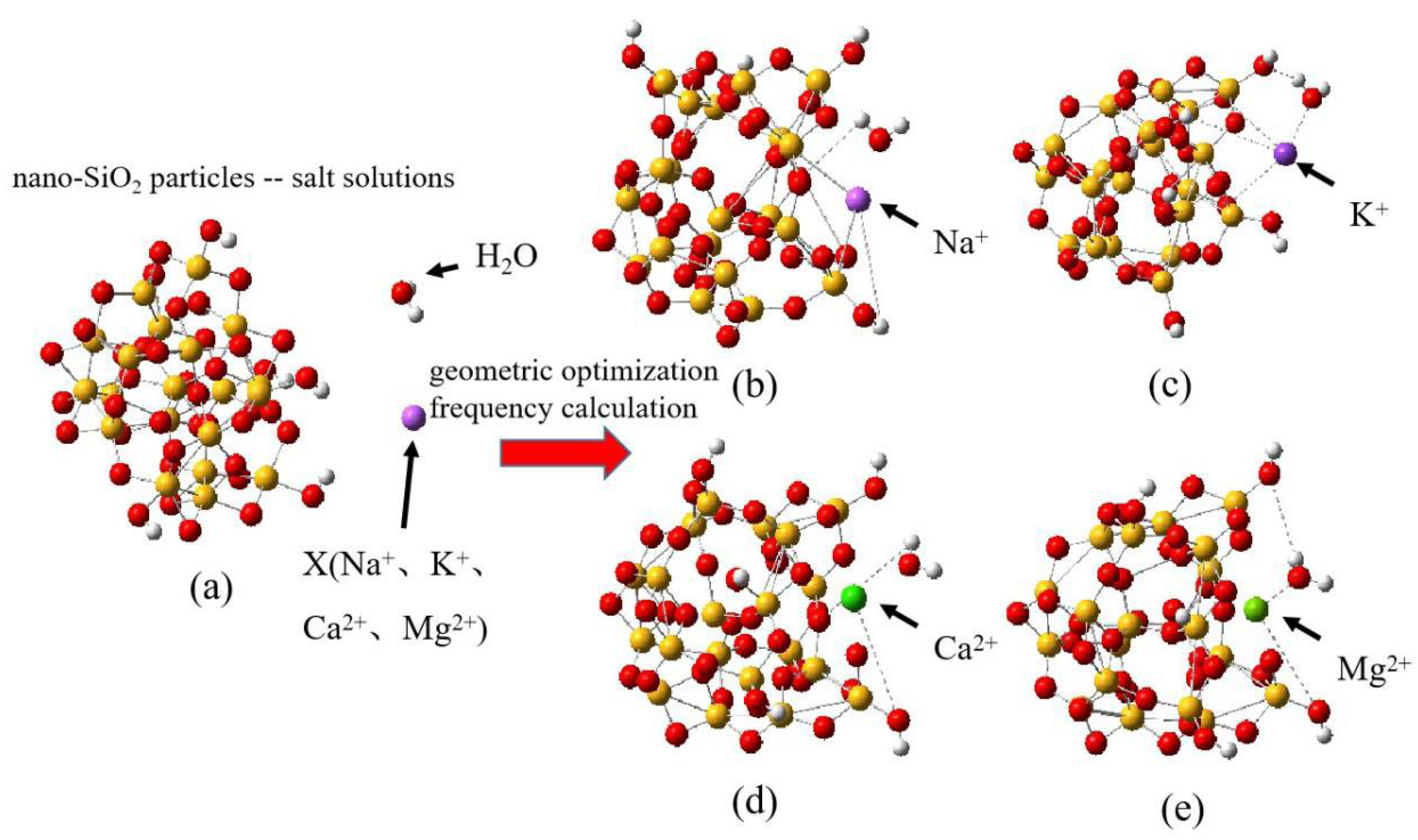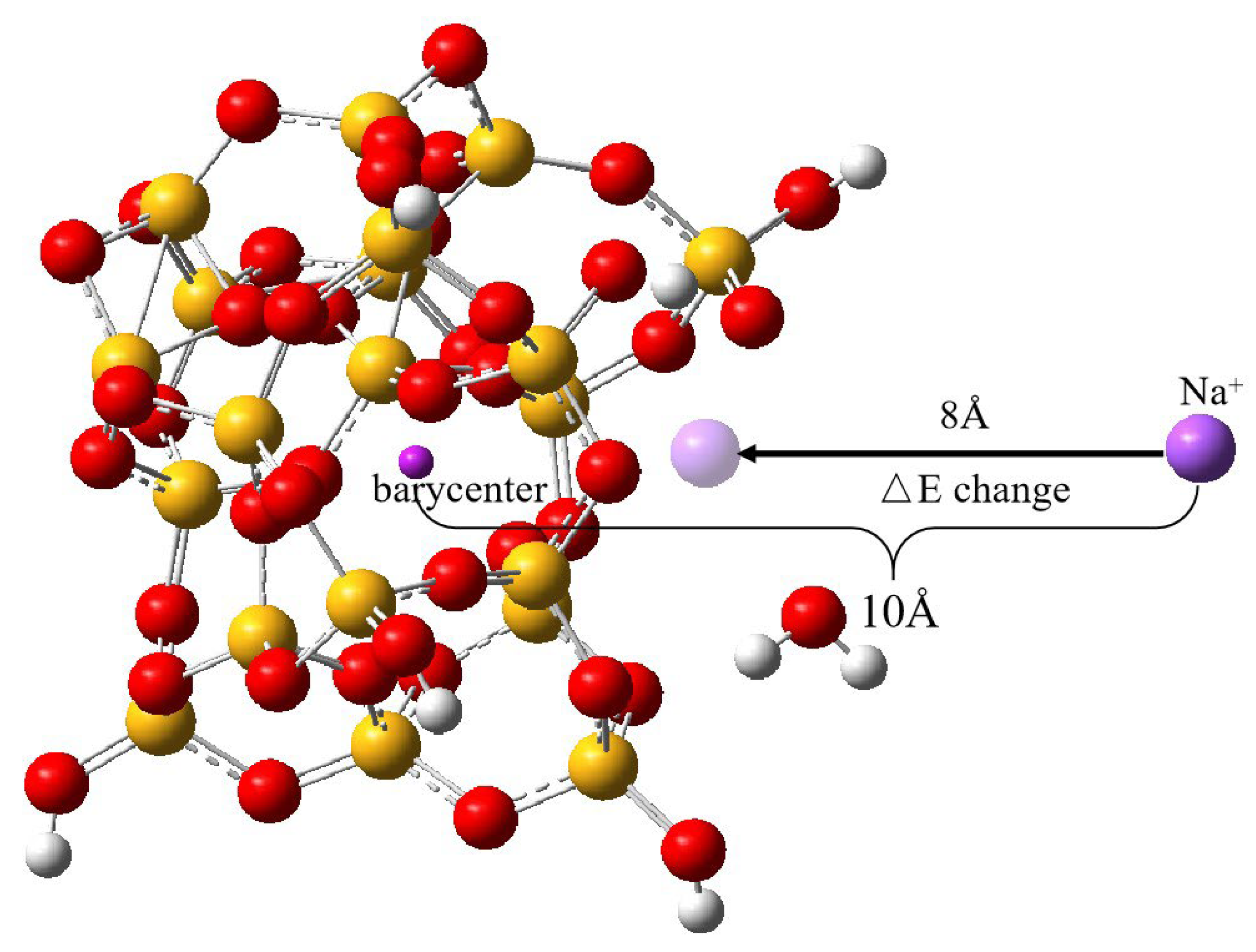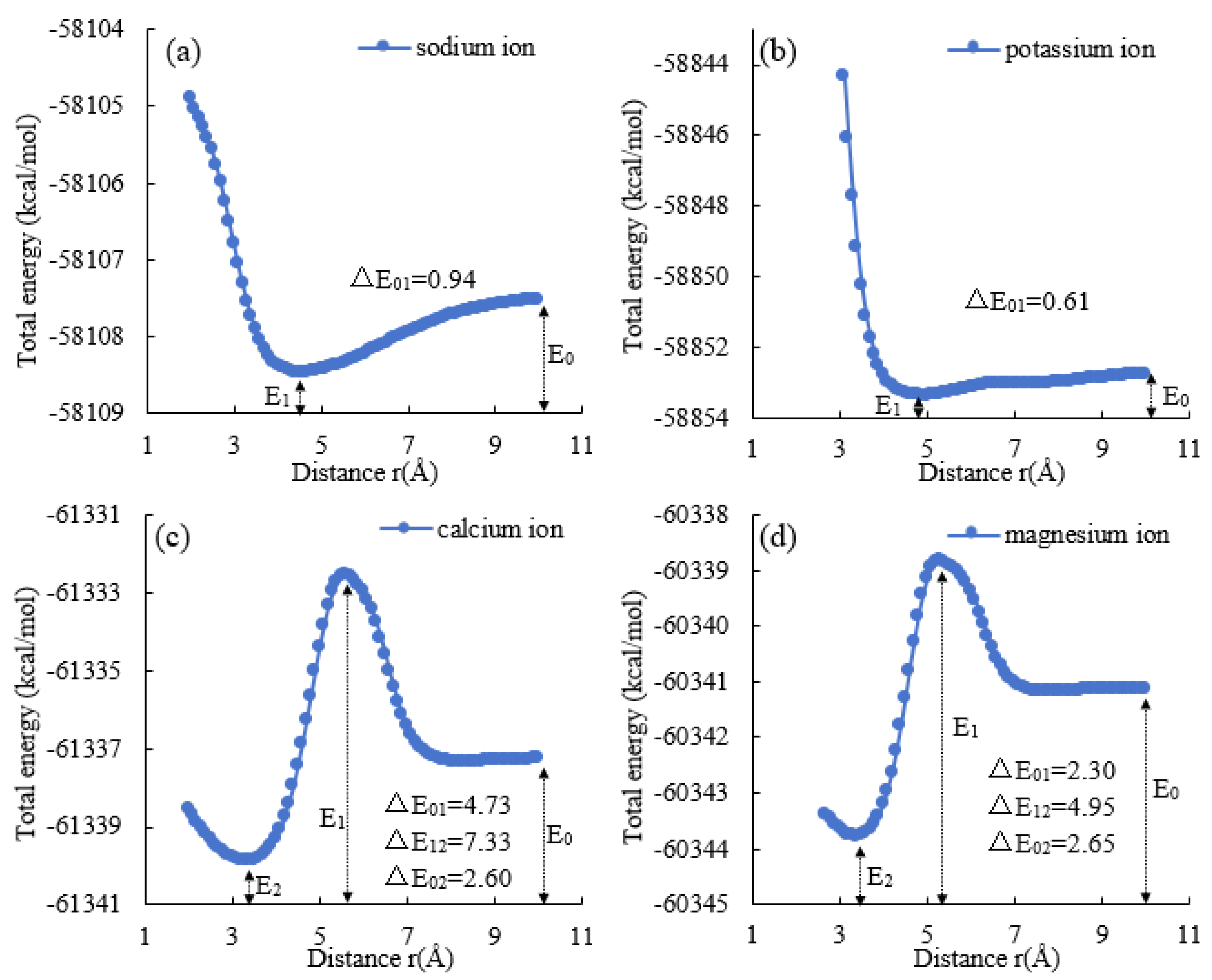Study on the Effect of Cations on the Surface Energy of Nano-SiO2 Particles for Oil/Gas Exploration and Development Based on the Density Functional Theory
Abstract
1. Introduction
2. Simulation Method of Density Functional Theory
2.1. Method of Construction of the Nano SiO2–Cation Model
2.2. Potential Energy Surface Scanning Method
2.3. Decomposition Method of Interaction Energy
3. Results and Discussion
3.1. Analysis of Potential Energy Surface of Cation–Nano SiO2 Particle Model
3.2. Decomposition of Interaction Energy of Nano SiO2 Particle-–Cation Model
3.3. Variation of Charge in the Nano SiO2–Cation Model
4. Conclusions
Author Contributions
Funding
Institutional Review Board Statement
Informed Consent Statement
Data Availability Statement
Conflicts of Interest
References
- Hu, W.; Wei, Y.; Bao, J. Development of the theory and technology for low permeability reservoirs in China. Pet. Explor. Dev. 2018, 45, 646–656. [Google Scholar] [CrossRef]
- Yuan, S.; Wang, Q. New progress and prospect of oilfields development technologiess in China. Pet. Explor. Dev. 2018, 45, 657–668. [Google Scholar] [CrossRef]
- Fang, X.Y.; Deng, B.; Geng, A.S.; Liu, S.F.; Wang, P.F.; Liang, X.; Li, Y.; Cheng, B.; Jiang, W.M.; Wu, L.L. Geochemical properties, mechanism of formation, and source of solid bitumen in the Ediacaran Dengying Formation from the central to northern Sichuan Basin, China. Mar. Pet. Geol. 2024, 159, 106573. [Google Scholar] [CrossRef]
- Radwan, A.E.; Yin, S.; Hakimi, M.H.; Li, H. Petroleum geology of conventional and unconventional resources: Introduction. Geol. J. 2023, 58, 3965–3969. [Google Scholar] [CrossRef]
- Qin, T.Z.; Fenter, P.; AlOtaibi, M.; Ayirala, S.; AlYousef, A. Pore-Scale Oil Connectivity and Displacement by Controlled-Ionic-Composition Waterflooding Using Synchrotron X-ray Microtomography. SPE J. 2021, 26, 3694–3701. [Google Scholar] [CrossRef]
- Lei, Q.; Weng, D.W.; Luo, J.H.; Zhang, J.J.; Li, Y.L.; Wang, X.; Guan, B.S. Achievements and future work of oil and gas production engineering of CNPC. Pet. Explor. Dev. 2019, 46, 145–152. [Google Scholar] [CrossRef]
- Lau, H.C.; Yu, M.; Nguyen, Q.P. Nanotechnology for oilfield applications: Challenges and impact. J. Pet. Sci. Eng. 2017, 157, 1160–1169. [Google Scholar] [CrossRef]
- Alsaba, M.T.; Al Dushaishi, M.F.; Abbas, A.K. A comprehensive review of nanoparticles applications in the oil and gas industry. J. Pet. Explor. Prod. Technol. 2020, 10, 1389–1399. [Google Scholar] [CrossRef]
- Liu, H.; Jin, X.; Ding, B. Application of nanotechnology in petroleum exploration and development. Pet. Explor. Dev. 2015, 33, 639–657. [Google Scholar] [CrossRef]
- Liu, J.C.; Zhang, Y.D.; Wei, M.Z.; He, X.M.; Bai, B.J. Fabrications and Applications of Micro/Nanofluidics in Oil and Gas Recovery: A Comprehensive Review. Energy Fuels 2022, 36, 9904–9931. [Google Scholar] [CrossRef]
- Rafati, R.; Smith, S.R.; Haddad, A.S.; Novara, R.; Hamidi, H. Effect of nanoparticles on the modifications of drilling fluids properties: A review of recent advances. J. Pet. Sci. Eng. 2018, 161, 61–76. [Google Scholar] [CrossRef]
- Jiang, G.C.; Ni, X.X.; Yang, L.L.; Li, W.Q.; Li, Y.Y.; Deng, Z.Q. Synthesis of superamphiphobic nanofluid as a multi-functional additive in oil-based drilling fluid, especially the stabilization performance on the water/oil interface. Colloid Surf. A Physicochem. Eng. Asp. 2020, 588, 124385. [Google Scholar] [CrossRef]
- Luo, X.W.; Jiang, G.C.; Wang, G.S.; Yang, L.L.; He, Y.B.; Cui, K.X.; Yang, J. Novel approach to improve shale stability using super-amphiphobic nanoscale materials in water-based drilling fluids and its field application. Rev. Adv. Mater. Sci. 2022, 61, 41–54. [Google Scholar] [CrossRef]
- Ngata, M.R.; Yang, B.L.; Aminu, M.D.; Emmanuely, B.L.; Said, A.A.; Kalibwami, D.C.; Mwakipunda, G.C.; Ochilov, E.; Nyakilla, E.E. Minireview of Formation Damage Control through Nanotechnology Utilization at Fieldwork Conditions. Energy Fuels 2022, 36, 4174–4185. [Google Scholar] [CrossRef]
- Zhao, K.; Wang, X.D.; Pan, H.; Li, Q.Y.; Yang, J.J.; Li, X.H.; Zhang, Z.J. Preparation of molybdenum-doped akaganeite nano-rods and their catalytic effect on the viscosity reduction of extra heavy crude oil. Appl. Surf. Sci. 2018, 427, 1080–1089. [Google Scholar] [CrossRef]
- Zhou, M.; Yang, X.L.; Gao, Z.D.; Wu, X.Y.; Li, L.K.; Guo, X.; Yang, Y.Z. Preparation and performance evaluation of nanoparticle modified clean fracturing fluid. Colloid Surf. A Physicochem. Eng. Asp. 2022, 636, 128117. [Google Scholar] [CrossRef]
- Zhang, Q.D.; Qian, J.Q.; Guo, H.; Zhang, W.; Kuang, C.L. Utilization of Nano-SiO2 as a Supporting Material for Immobilization of Porcine Pancreatic Lipase. J. Nanosci. Nanotechnol. 2018, 18, 5837–5841. [Google Scholar] [CrossRef]
- Tang, X.C.; Kang, W.L.; Zhou, B.B.; Gao, Y.B.; Cao, C.X.; Guo, S.J.; Iqbal, M.W.; Yang, H.B. Characteristics of composite microspheres for in-depth profile control in oilfields and the effects of polymerizable silica nanoparticles. Powder Technol. 2020, 359, 205–215. [Google Scholar] [CrossRef]
- Xu, B.B.; Zhang, Q.H. Preparation and Properties of Hydrophobically Modified Nano-SiO2 with Hexadecyltrimethoxysilane. ACS Omega 2021, 6, 9764–9770. [Google Scholar] [CrossRef]
- Luo, J.H.; Du, Z.P.; Tai, X.M.; Wang, W.X.; Wu, J.H.; Ding, B.; Wang, P.M. One-Pot Preparation of Nano-SiO2 Using a Silane Derivative as a Coupling Agent. Tenside Surfact. Det. 2016, 53, 278–283. [Google Scholar] [CrossRef]
- Zhang, R.J.; Yang, K.; Xiong, T.Y. Research on a new process of preparation for nano-SiO2 with high activity and mesopores. J. Mater. Sci. Technol. 2004, 20, 353–356. [Google Scholar]
- Skinner, J.L. Following the Motions of Water molecules in Aqueous Solutions. Science 2010, 328, 985–986. [Google Scholar] [CrossRef] [PubMed]
- Lam, Y.; Abramov, Y.; Ananthula, R.S.; Elward, J.M.; Hilden, L.R.; Lill, S.O.N.; Norrby, P.; Ramirez, A.; Sherer, E.C.; Mustakis, J.; et al. Applications of Quantum Chemistry in Pharmaceutical Process Development: Current State and Opportunities. Org. Process Res. Dev. 2020, 24, 1496–1507. [Google Scholar] [CrossRef]
- Menon, A.; Pascazio, L.; Nurkowski, D.; Farazi, F.; Mosbach, S.; Akroyd, J.; Kraft, M. OntoPESScan: An Ontology for Potential Energy Surface Scans. ACS Omega 2023, 8, 2462–2475. [Google Scholar] [CrossRef] [PubMed]
- Tecmer, P.; Boguslawski, K.; Borkowski, M.; Żuchowski, P.S.; Kędziera, D. Modeling the electronic structures of the ground and excited states of the ytterbium atom and the ytterbium dimer: A modern quantum chemistry perspective. Int. J. Quantum Chem. 2020, 119, e25983. [Google Scholar] [CrossRef]
- Besler, B.H.; Merz, K.M.; Kollman, P.A. Atomic charges derived from semiempirical methods. J. Comput. Chem. 1990, 11, 431–439. [Google Scholar] [CrossRef]
- Mitsui, T.; Rose, M.K.; Fomin, E.; Ogletree, D.F.; Salmeron, M. Water diffusion and clustering on Pd(111). Science 2002, 297, 1850–1852. [Google Scholar] [CrossRef]
- Scatena, L.F.; Brown, M.G.; Richmond, G.L. Water at hydrophobic surfaces: Weak hydrogen bonding and strong orientation effects. Science 2001, 292, 908–912. [Google Scholar] [CrossRef]
- De Lara, L.S.; Rigo, V.A.; Miranda, C.R. Controlling Clay Swelling-Shrinkage with Inorganic Nanoparticles: A Molecular Dynamics Study. J. Phys. Chem. C 2017, 121, 20266–20271. [Google Scholar] [CrossRef]
- De Lara, L.S.; Rigo, V.A.; Miranda, C.R. The stability and interfacial properties of functionalized silica nanoparticles dispersed in brine studied by molecular dynamics. Eur. Phys. J. B 2015, 88, 261. [Google Scholar] [CrossRef]
- DelloStritto, M.J.; Kubicki, J.D.; Sofo, J.O. Effect of Ions on H-Bond Structure and Dynamics at the Quartz(101)-Water Interface. Langmuir 2016, 32, 11353–11365. [Google Scholar] [CrossRef] [PubMed]
- Li, J.; Cramer, C.J.; Truhlar, D.G. Application of a universal solvation model to nucleic acid bases: Comparison of semiempirical molecular orbital theory, ab initio Hartree-Fock theory, and density functional theory. Biophys. Chem. 1999, 78, 147–155. [Google Scholar] [CrossRef] [PubMed]
- Teotia, J.; Kumar, V.; Annu; Bhardwaj, S.; Rathi, I. Experimental (ft-raman, ft-ir and nmr) and theoretical (dft) calculations, thermodynamic parameters, molecular docking and nlo (non-linear optical) properties of n-(2,6-dimethylphenyl)-1-piperazineacetamide. Int. J. Mater. Res. 2023, 114, 536–554. [Google Scholar] [CrossRef]
- Lu, J.; Lu, Q.H.; Li, X.J. Quantum chemistry calculations of the growth patterns, simulated photoelectron spectra, and electronic properties of LaASil (A = Sc, Y, La; l ≤ 10) compounds and their anions. Phys. Chem. Chem. Phys. 2021, 23, 25679–25688. [Google Scholar] [CrossRef] [PubMed]
- Seth, R.; Singh, A. Rational design of co-ordination compounds in combination of bipyridine type of ligands and group 7 metal (M = Mn, Re) for photoCORM: A DFT study. J. Mol. Model. 2023, 29, 306. [Google Scholar] [CrossRef] [PubMed]
- Shi, B.; Yu, J.; Tang, T.; Li, Y.; Tang, Y. Calculation of the UV Spectrum and Electrophilic Reactive Sites of Fentanyl Molecule Based on the Density Functional Theory. Russ. J. Phys. Chem. 2020, 94, 2586–2593. [Google Scholar] [CrossRef]
- Creazzo, F.; Luber, S. Explicit solvent effects on (110) ruthenium oxide surface wettability: Structural, electronic and mechanical properties of rutile ruo 2 by means of spin-polarized dft-md. Appl. Surf. Sci. 2021, 570, 15039. [Google Scholar] [CrossRef]
- Ovalle, S.; Malardier-Jugroot, C. Choice of functional for iron porphyrin density functional theory studies: Geometry, spin-state, and binding energy analysis. Comput. Theor. Chem. 2022, 1213, 113726. [Google Scholar] [CrossRef]
- Jiang, D.P.; Zhu, C.C.; Shao, X.S.; Cheng, J.G.; Li, Z. Bioactive conformation analysis of anthranilic diamide insecticides: DFT-based potential energy surface scanning and 3D-QSAR investigations. Chin. Chem. Lett. 2015, 26, 662–666. [Google Scholar] [CrossRef]
- Alipour, M.; Kargar, K. Anionic behavior and single-molecule crystal in fullerene confinements: A contribution from DFT energy decomposition and cooperativity analyses. J. Comput. Chem. 2020, 41, 1912–1920. [Google Scholar] [CrossRef]
- Fojcik, L.; Latajka, Z. The nature of halogen bond in model OC⋯XY systems from the energy decomposition analysis perspective. Comput. Theor. Chem. 2021, 1202, 113342. [Google Scholar] [CrossRef]
- Zhang, Q.; Chen, T.; Ma, L.J.; Tang, Z.Q.; Yu, L.X. Decoding the terahertz spectrum of allantoin crystal using DFT simulations and energy decomposition analysis. Chem. Phys. Lett. 2021, 767, 138350. [Google Scholar] [CrossRef]
- Fang, D.; Piquemal, J.P.; Liu, S.B.; Cisneros, G.A. DFT-steric-based energy decomposition analysis of intermolecular interactions. Theor. Chem. Acc. 2014, 133, 1484. [Google Scholar] [CrossRef]
- Gao, W.; Feng, H.J.; Xuan, X.P.; Chen, L.P. The assessment and application of an approach to noncovalent interactions: The energy decomposition analysis (EDA) in combination with DFT of revised dispersion correction (DFT-D3) with Slater-type orbital (STO) basis set. J. Mol. Model. 2012, 18, 4577–4589. [Google Scholar] [CrossRef] [PubMed]
- Xu, Y.; Zhang, S.; Wu, W.; Su, P.F. Assessments of DFT-based energy decomposition analysis methods for intermolecular interactions. J. Chem. Phys. 2023, 158, 124116. [Google Scholar] [CrossRef] [PubMed]
- Akman, F. Effect of solvents on intra- and inter-molecular interactions of oligothiophenes. J. Mol. Model. 2023, 29, 276. [Google Scholar] [CrossRef] [PubMed]
- Vimala, M.; Mary, S.S.; Irfan, A.; Muthu, S. Solvent role in molecular structure, thermodynamic quantities, reactions and electronic transitions (TDDFT) on 2- piperidin-1-yl phenol. J. Mol. Liq. 2023, 375, 121313. [Google Scholar] [CrossRef]
- Jaillet, L.; Artemova, S.; Redon, S. IM-UFF: Extending the universal force field for interactive molecular modeling. J. Mol. Graph. Model. 2017, 77, 350–362. [Google Scholar] [CrossRef]
- Jász, A.; Rák, A.; Ladjánszki, I.; Cserey, G. Optimized GPU implementation of Merck Molecular Force Field and Universal Force Field. J. Mol. Struct. 2019, 1188, 227–233. [Google Scholar] [CrossRef]




| System | Total Interaction Energy (kcal/mol) | Electrostatic Energy (kcal/mol) | Exchange Exclusive Energy (kcal/mol) | Dispersion Energy (kcal/mol) |
|---|---|---|---|---|
| Na+ | ||||
| SiO2-Na+ | −2.96858 | −3.17415 | 0.337193 | −0.13159 |
| SiO2-H2O | 0.50269 | 0.139098 | 0.667691 | −0.30421 |
| Na+-H2O | −1.0045 | −1.12385 | 0.159398 | −0.03991 |
| K+ | ||||
| SiO2-K+ | −1.94638 | −2.06466 | 0.303095 | −0.1848 |
| SiO2-H2O | 1.016983 | −0.02717 | 1.272281 | −0.2281 |
| K+-H2O | −0.79818 | −0.8903 | 0.132697 | −0.0406 |
| Ca2+ | ||||
| SiO2-Ca2+ | −5.21955 | −7.45947 | 3.043551 | −0.80358 |
| SiO2-H2O | 0.374793 | 0.398494 | 0.149897 | −0.17357 |
| Ca2+-H2O | −1.5353 | −1.93716 | 0.524389 | −0.12249 |
| Mg2+ | ||||
| SiO2-Mg2+ | −2.0102 | −5.60132 | 4.277235 | −0.68617 |
| SiO2-H2O | 0.413491 | 0.302995 | 0.408992 | −0.2985 |
| Mg2+-H2O | −1.11206 | −1.7934 | 0.825388 | −0.14407 |
Disclaimer/Publisher’s Note: The statements, opinions and data contained in all publications are solely those of the individual author(s) and contributor(s) and not of MDPI and/or the editor(s). MDPI and/or the editor(s) disclaim responsibility for any injury to people or property resulting from any ideas, methods, instructions or products referred to in the content. |
© 2024 by the authors. Licensee MDPI, Basel, Switzerland. This article is an open access article distributed under the terms and conditions of the Creative Commons Attribution (CC BY) license (https://creativecommons.org/licenses/by/4.0/).
Share and Cite
Ni, J.; Zhang, L.; Wang, C.; Wang, W.; Jin, G. Study on the Effect of Cations on the Surface Energy of Nano-SiO2 Particles for Oil/Gas Exploration and Development Based on the Density Functional Theory. Molecules 2024, 29, 916. https://doi.org/10.3390/molecules29040916
Ni J, Zhang L, Wang C, Wang W, Jin G. Study on the Effect of Cations on the Surface Energy of Nano-SiO2 Particles for Oil/Gas Exploration and Development Based on the Density Functional Theory. Molecules. 2024; 29(4):916. https://doi.org/10.3390/molecules29040916
Chicago/Turabian StyleNi, Jun, Lei Zhang, Chengjun Wang, Weibo Wang, and Ge Jin. 2024. "Study on the Effect of Cations on the Surface Energy of Nano-SiO2 Particles for Oil/Gas Exploration and Development Based on the Density Functional Theory" Molecules 29, no. 4: 916. https://doi.org/10.3390/molecules29040916
APA StyleNi, J., Zhang, L., Wang, C., Wang, W., & Jin, G. (2024). Study on the Effect of Cations on the Surface Energy of Nano-SiO2 Particles for Oil/Gas Exploration and Development Based on the Density Functional Theory. Molecules, 29(4), 916. https://doi.org/10.3390/molecules29040916






